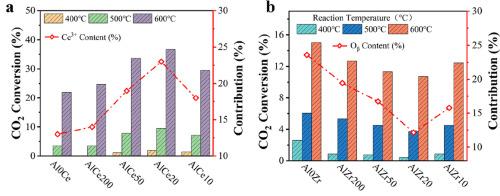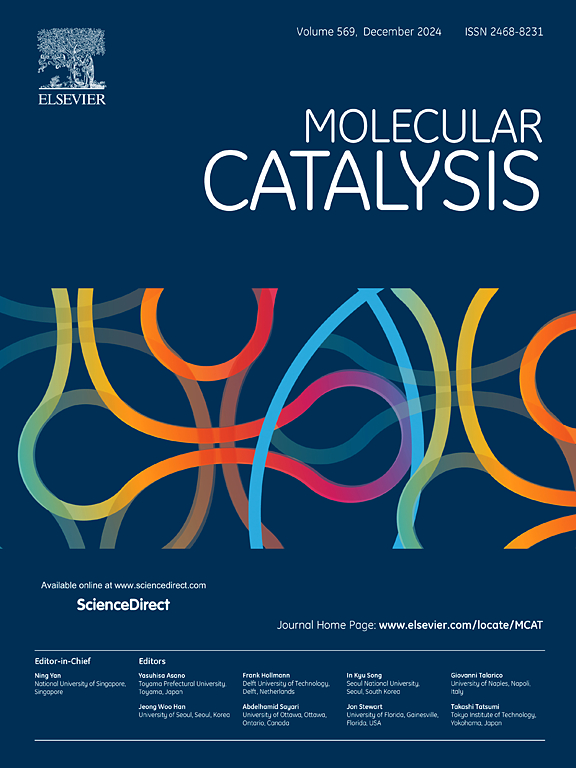通过系统地调整掺铝CeO2和ZrO2催化剂上的氧空位,增强CO2热还原成CO
IF 4.9
2区 化学
Q2 CHEMISTRY, PHYSICAL
引用次数: 0
摘要
二氧化碳排放导致的全球变暖带来了重大的环境挑战,促进了对催化二氧化碳转化技术的研究。因此,开发具有明确活性位点的简化催化剂结构对于推进该领域的发展至关重要。本文选择CeO2和ZrO2作为催化剂,因为它们具有良好的储氧能力和热还原CO2的氧化还原性能。系统地研究了Al掺杂对表面氧含量和催化性能的影响。采用H2-TPR、H2-TPD、CO2-TPD、XRD、EPR、TEM、原位FTIR等表征技术对其结构和表面性能进行分析。对于Al掺杂的CeO2, XPS和EPR结果表明Al的掺入增加了氧空位浓度和表面反应性,H2- tpr, H2- tpd和原位FTIR证实Al的掺入增加了H2活化和HCOO毒血症的形成,导致CO2转化的增强。AlCe20催化剂表现出优异的性能,在600℃下CO2转化率为36.66%,CO选择性为100%。此外,AlCe20催化剂在600°C下连续工作55小时后表现出显著的稳定性。相比之下,XRD和XPS结果表明,在ZrO2中掺杂Al稳定了四方相,但降低了表面氧的可用性,导致CO2转化率降低。未掺杂ZrO2的转化率最高,为15.04%(600℃)。这项工作对表面氧在CO2转化中的作用提供了有价值的见解,并强调了掺杂策略在催化剂设计中的重要性。本文章由计算机程序翻译,如有差异,请以英文原文为准。

Enhancing thermal CO2 reduction to CO through systematically tailoring oxygen vacancies on Al-doped CeO2 and ZrO2 catalysts
Global warming driven by CO2 emissions poses a significant environmental challenge, prompting research into catalytic CO2 conversion technologies. Therefore, developing simplified catalyst structures with well-defined active sites is crucial for advancing this field. Herein, CeO2 and ZrO2 were chosen as catalyst due to their excellent oxygen storage capacity and redox properties in thermal CO2 reduction. Al doping was systematically varied to explore its impact on surface oxygen species and catalytic performance. Characterization techniques including H2-TPR, H2-TPD, CO2-TPD, XRD, EPR, TEM, and in-situ FTIR were employed to analyze the structure and surface properties. For Al-doped CeO2, XPS and EPR results indicated that Al incorporation increased oxygen vacancy concentration and surface reactivity, H2-TPR, H2-TPD and in-situ FTIR confirmed that Al incorporation increased H2 activation and HCOO⁻ formation, leading to the enhancement of CO2 conversion. The AlCe20 catalyst exhibited exceptional performance with a CO2 conversion of 36.66 % at 600 °C and 100 % CO selectivity. Moreover, the AlCe20 catalyst demonstrated remarkable stability over 55 h of continuous operation at 600 °C. In contrast, XRD and XPS results showed that Al doping in ZrO2 stabilized the tetragonal phase but reduced surface oxygen availability, leading to decreased CO2 conversion. The undoped ZrO2 showed the highest conversion at 15.04 % (600 °C) among the tested samples. This work provides valuable insights into the role of surface oxygen species in CO2 conversion and highlights the importance of doping strategies in catalyst design.
求助全文
通过发布文献求助,成功后即可免费获取论文全文。
去求助
来源期刊

Molecular Catalysis
Chemical Engineering-Process Chemistry and Technology
CiteScore
6.90
自引率
10.90%
发文量
700
审稿时长
40 days
期刊介绍:
Molecular Catalysis publishes full papers that are original, rigorous, and scholarly contributions examining the molecular and atomic aspects of catalytic activation and reaction mechanisms. The fields covered are:
Heterogeneous catalysis including immobilized molecular catalysts
Homogeneous catalysis including organocatalysis, organometallic catalysis and biocatalysis
Photo- and electrochemistry
Theoretical aspects of catalysis analyzed by computational methods
 求助内容:
求助内容: 应助结果提醒方式:
应助结果提醒方式:


